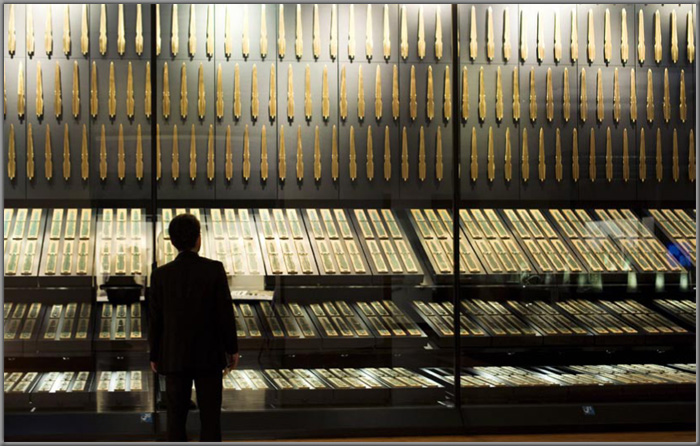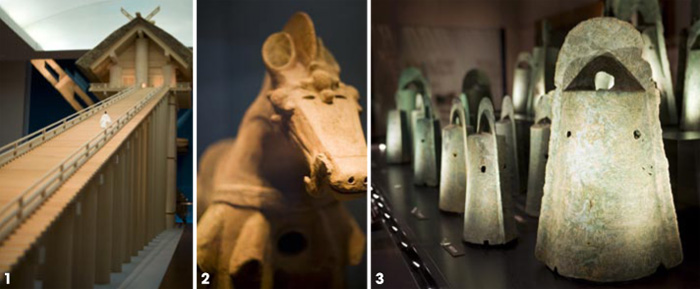Home > Highlighting JAPAN > Highlighting Japan DECEMBER 2012 > Shimane Museum of Ancient Izumo
Highlighting JAPAN
[SERIES] THE NATION'S MUSEUMS

Some of the 358 bronze swords discovered at the Kojindani site. The swords have been designated as national treasures.
Credit: ROB GILHOOLY
Shimane Museum of Ancient Izumo
Ongoing research to determine the true origins of Izumo-taisha grand shrine are documented in dazzling style in the nearby Shimane Museum of Ancient Izumo. Julian Ryall visits the museum.
The origins, history and even the design of Izumo-taisha grand shrine—one of the most important religious sites in all of Japan—are shrouded in mystery and legend. Close to the northern coast of what is today known as Shimane Prefecture, no written records survive of when this Shinto shrine was first built, while there has been much debate over the design of the earliest structures to grace the site.
However, described as far back as 950 CE as being around 48 meters tall, the shrine is believed to have been conceived as a place where the gods could reside.
In 2000, excavations of the site uncovered the remains of massive tree trunks that had been bound together to form the stilts upon which the structure stood, reinforcing the theory of how a shrine dedicated to the divinity Okuninushi, the "Great Land Master," once looked.
Today, work continues at the site to determine the history of Izumo-taisha and is detailed at the nearby Shimane Museum of Ancient Izumo.
"Five groups have proposed different designs for how the shrine looked in the past, but the size of the supporting posts indicates it was at least a very large structure," says Masashi Asanuma, curator of the museum. "We believe it stood on very high pillars and was reached by a staircase that was 109 meters long, but it is hard to know more about the design or even the color that it was painted."
And while the history of the shrine is a central part of the exhibitions, the museum also recounts the wider history and culture of Shimane.
Visitors to the museum step back into time as we view lifelike models of the people who lived in the villages that dotted the region many hundreds of years ago. Sections are given over to the jasper and agate beads that were shaped into tubes and comma shapes and apparently used for jewelry; others show how Sueki pottery was perfected in hillside kilns and, in later centuries, how silver was mined at the Iwami-Ginzan mine. Experts believe that as much as 38 tons of silver were mined each year at the peak of the output.
Among all the items on display, however, one stands out to this visitor. A whole exhibition hall has been set aside to show off one of the most remarkable discoveries in Japanese archeological history, that of 358 bronze swords that had been buried alongside each other, as well as a number of bronze spear heads and stylized bronze bells, many etched with designs or images of deer, turtles and other animals.
The artifacts, uncovered on a forested hillside in 1984, were the work of people from the Yayoi period in history, some 2,000 years ago, and were all very similar in design.
Each of the blades had been carefully created before being laid out in neat rows and then buried. The experts are divided on why the weapons were left at this spot, but their discovery inevitably raises hopes that more such caches are waiting to be discovered in the hills that surround the museum.
1) This 1/10 model shows how the main building of Izumo-taisha grand shrine is thought to have once looked. 2) Sixth-century clay figures recovered from the Shimoyama site 3) Some of the thirty-nine bronze bells excavated at the Kamo-Iwakura site. The vessels are thought to have been used in religious festivals.
Credit: ROB GILHOOLY
| The Shimane Museum of Ancient Izumo | |
| Address: | 99-4 Kizukihigashi, Taisha-cho, Izumo, Shimane Prefecture 699-0701. |
| Tel.: | +81 853 53 8600 |
| Fax.: | +81 853 53 5350 |
| Website: | http://www.izm.ed.jp/english/ |
| Holidays: | Closed every third Tuesday, unless the day is a national holiday, when the museum is closed on the following day. |
| Entrance: | 600 yen for adults, 400 yen for university students and 200 yen for pupils. (Note: 50% discount for foreign visitors. Pupils are admitted free of charge until March 31, 2013.) |
© 2009 Cabinet Office, Government of Japan







